The Columbia Accident Investigation Board announced today that the foam theory was the “most probable cause” of the space shuttle tragedy. Based on analysis from tons of Columbia debris, they believe there is compelling evidence that a large chunk of foam fell off the fuel tank on launch and cracked a critical heat shield on the shuttle’s wing. Upon re-entry several days later, hot air flowed inside the wing and melted metal braces, and eventually tore the wing off – the entire shuttle came apart moments after that. The investigators are working on their final report, which is due in July.
Mars Surveyor Snaps Phobos
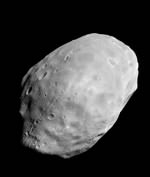
Image credit: NASA/JPL
NASA’s Mars Global Surveyor took several photos of Mars’ moon Phobos on June 1, 2003. The first image is a low-resolution shot of Phobos about to set behind the Red Planet; while the second, higher resolution image shows incredible details on the moon’s surface. Phobos orbits Mars three times a day at an average distance of only 9,378 kilometres – if you stood on the surface of Phobos, Mars would nearly fill the sky above.
Mars has two natural satellites, or moons, Phobos and Deimos. On 1 June 2003, the Mars Global Surveyor (MGS) spacecraft was slewed eastward to capture these views of the inner moon, Phobos, shortly before it set over the afternoon limb. Phobos orbits Mars about 3 times a day at a distance of about 6,000 km (3,728 mi). About 0.006 times the size of Earth’s Moon, Phobos is a potato-shaped object with dimensions approximately 27 by 22 by 18 kilometers (about 17 by 14 by 11 miles).
The first picture shown here is a color composite of four MGS Mars Orbiter Camera (MOC) wide angle images; the second is the same as the first, but indicates the location of Phobos. The third view is a MOC narrow angle image, taken at the same time as the wide angle views, showing details on the surface of the tiny moon.
Phobos is one of the darkest objects in the Solar System. Thus, four wide angle images were obtained to make the picture of Phobos over the martian limb: a pair of red and blue wide angle images was acquired for the limb, and a pair of separate images were required to see Phobos. The wide angle images illustrate the fact that Phobos is mostly colorless (dark gray); the faint orange/red hue in the wide angle picture is a combination of slight differences in the focal lengths of the blue and red cameras and the orange/red illumination provided by reflection of sunlight off Mars. To a person standing on Phobos, the red planet would fill most of the sky.
The high resolution image (bottom) was taken at the same time as the wide angle views. MGS was about 9,670 kilometers (6,010 miles) from Phobos when the picture was taken. At this distance, the image resolution is about 36 meters (118 ft.) per pixel; the maximum dimension of Phobos as seen in this image (the diagonal from lower left to upper right) is just over 24 km (15 mi). This is the “trailing” hemisphere, the part of Phobos that faces opposite the direction that the moon orbits Mars. This is a part of Phobos that was not seen by MOC in 1998, when MGS made several close flybys of the tiny moon.
The rows of grooves and aligned pits on Phobos are related to, and were probably caused by, a large meteor impact that occurred on the side of Phobos that is not seen here. That large crater, Stickney, was named for the maiden name of the wife of the astronomer that discovered Phobos and the other martian satellite, Deimos, in 1877, Asaph Hall.
Original Source: MSSS News Release
Opportunity Pushed Back a Day
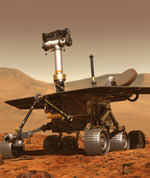
Image credit: NASA/JPL
NASA decided to push back the launch of the second Mars Explorer rover this week because of a minor problem with its Delta rocket. Engineers decided to replace a protective band of cork insulation on the rocket’s first stage. The time to make this replacement will push back the launch of “Opportunity” to Sunday, June 29 at 0356 GMT (11:56 pm Saturday EDT). If all goes well, Opportunity will follow Spirit, which is already on its way to Mars, and is expected to arrive in early January 2004.
The Flight Readiness Review was held today for the MER-B launch of the ?Opportunity? Mars Exploration Rover. Afterward, a decision was made to postpone the launch by at least a couple of days.
Based on routine post-test inspections, the launch team has elected to remove and replace a band of protective cork insulation on the Delta first stage. The location is below the forward attach points of the strap-on solid rocket boosters. Inspections of a second band located higher on the first stage are being performed.
The time necessary to do this work means a rescheduling of the launch to no earlier than Saturday, June 28 at 11:56:16 p.m. EDT. A firm date will be established on Monday after the engineering team reconvenes.
Original Source: NASA News Release
Adaptive Optics Improve Images of the Sun
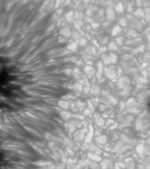
Image credit: NSO
A new adaptive optics system is helping the National Solar Observatory take much more vivid images of the Sun. Earth-based telescopes are limited in resolution by atmospheric distortion, so there was no real point of building them larger than 1.5 metres across – bigger didn’t help. With the new NSO system; however, solar telescopes can now be built 4-metres and larger. This should allow solar astronomers to better understand the processes of solar magnetism and other activities.
Impressive, sharp images of the Sun can be produced with an advanced adaptive optical system that will give new life to existing telescopes and open the way for a generation of large-aperture solar telescopes. This AO system removes blurring introduced by Earth’s turbulent atmosphere and thus provides a clear vision of the smallest structure on the Sun.
The new AO76 system — Adaptive Optics, 76 subapertures — is the largest system designed for solar observations. As demonstrated recently by a team at the National Solar Observatory at Sunspot, NM, AO76 produces sharper images under worse seeing conditions for atmospheric distortion than the AO24 system employed since 1998.
“First light” with the new AO76 system was in December 2002, followed by tests starting in April 2003 with a new high-speed camera that significantly enhanced the system.
“If the first results in late 2002 with the prototype were impressive,” said Dr. Thomas Rimmele, the AO project scientist at the NSO, “I would call the performance that we are getting now truly amazing. I’m quite thrilled with the image quality delivered by this new system. I believe its fair to say that the images we are getting are the best ever produced by the Dunn Solar Telescope.” The Dunn is one of the nation’s premier solar observing facilities.
Dual-purpose program
The new high-order AO system serves two purposes. It will allow existing solar telescopes, like the 76-cm (30-inch) Dunn, to produce higher resolution images and greatly improve their scientific output under a wider range of seeing conditions. It also demonstrates the ability to scale the system up to enable a new generation of large-aperture instruments, including the proposed 4-meter Advanced Technology Solar Telescope (see below) that will see at higher resolutions than current telescopes can achieve.
High resolution observations of the Sun have become increasingly important for solving many of the outstanding problems in solar physics. Studying the physics of flux elements, or solar fine structure in general, requires spectroscopy and polarimetry of the fine structures. The exposures are typically about 1 second long and the resolution currently achieved in spectroscopic/polarimetric data typically is 1 arc-second, which is insufficient for study of fine solar structures. Further, theoretical models predict structures below the resolution limits of 0.2 arc-sec of existing solar telescopes. Observations are needed below the 0.2 arc-sec resolution limit to study the important physical processes that occur on such small scales. Only AO can provide a consistent spatial resolution of 0.1 arc-sec or better from ground based observatories.
AO technology combines computers and flexible optical components to reduce the effects of atmospheric blurring (“seeing”) on astronomical images. Sunspot’s solar AO76 system is based on the Shack-Hartmann correlating technique. In essence, this divides an incoming image into an array of subapertures viewed by a wavefront sensor camera. One subaperture is selected as a reference image. Digital signal processors (DSPs) calculate how to adjust each subaperture to match the reference image. The DSPs then command 97 actuators to reshape a thin, 7.7 cm (3-inch) deformable mirror to cancel much of the blurring. The DSP also can drive a tilt/tip mirror, mounted in front of the AO system, that removes gross image motion caused by the atmosphere.
Closing the loop for sharper images
“A major challenge for astronomers is correcting the light entering their telescopes for the effect of the Earth’s atmosphere,” explained Kit Richards, NSO’s AO lead project engineer. “Air of different temperatures mixing above the telescope makes the atmosphere like a rubber lens that reshapes itself about a hundred times each second.” This is more severe for solar astronomers observing during the day with the Sun heating Earth’s surface, but still causes the stars to twinkle at night.
Further, solar physicists want to study extended bright regions with low contrast. That makes it more challenging for an AO system to correlate the same parts of several slightly different subapertures, and to maintain the correlation from one image frame to the next as the atmosphere changes shape.
(Nighttime astronomy has used a different technique for several years. Lasers generate artificial guide stars in the atmosphere, letting astronomers measure and correct for atmospheric distortion. This is not practical with instruments that observe the Sun.)
In 1998 NSO pioneered use of a low-order AO24 system for solar observations. It has 24 apertures and compensates 1,200 times/second (1,200 Hertz [Hz]). Since August 2000, the team focused on scaling the system up to the high-order AO76 with 76 apertures and correcting twice as fast, 2,500 Hz. The breakthroughs started in late 2002.
First, the servo loop was successfully closed on the new high-order AO system during its first engineering run at the Dunn in December. In a “closed loop” servo system the output is fed back to the input and the errors are driven to 0. An “open loop” system detects the errors and makes corrections but the corrected output is not feed back to the input. The servo system doesn’t know if it is removing all the errors or not. This type of system is faster but very hard to calibrate and keep calibrated. At this point the system used a DALSA camera, which operates at 955 Hz, as the interim wavefront sensor. The optical setup was not finalized and preliminary; “bare-bone” software operated the system.
High-speed wavefront sensor
Even in this preliminary state — intended to demonstrate that the components worked together as a system– and under mediocre seeing conditions, the high-order AO system produced impressive, diffraction-limited images. Time sequences of corrected and uncorrected images show that the new AO system provides fairly consistent high-resolution imaging even as the seeing varies substantially, as is typical for daytime seeing.
Following this milestone, the team installed a new high-speed wavefront sensor camera custom developed for the AO project by Baja Technology and NSO’s Richards. It operates at 2,500 frames/second, which more than doubles the closed-loop servo bandwidth possible with the DALSA camera. Richards also implemented improved control software. In addition, the system was upgraded to drive the tip/tilt correction mirror either directly from the AO wavefront sensor or from a separate correlation/spot tracker system that operates at 3 kHz.
The new high-order AO76 was first tested in April 2003 and immediately started producing excellent images under a wider range of seeing conditions that normally would preclude high-resolution images. The new high-order AO76 was first tested in April 2003 and immediately started producing excellent images under a wider range of seeing conditions that normally would preclude high-resolution images. Striking differences with the AO on versus off are readily visible in images of active areas, granulation, and other features.
“That’s not to say that seeing does not matter anymore,” Rimmele noted. “To the contrary, seeing effects such as anisoplanatism — wavefront differences between the correlation target and the area we want to study — still are limiting factors. But in halfway decent seeing we can lock up on granulation and record excellent images.”
To make large instruments like the Advanced Technology Solar Telescope possible, the high-order AO system will have to be scaled up more than tenfold to at least 1,000 subapertures. And NSO is looking beyond that to a more complex technique, multiconjugate AO. This approach, already being developed for nighttime astronomy, builds a three-dimensional model of the turbulent region rather than treating it as a simple distorted lens.
For now, though, the project team will focus on the completion of the optical setup at the Dunn, installation of the AO bench at the Big Bear Solar Observatory followed by engineering runs, optimization of reconstruction equations and servo loop controls, and characterization of system performance at both sites. Then, the Dunn AO system is to become operational in fall of 2003. The Diffraction Limited Spectro-Polarimeter (DLSP), the main science instrument that can take advantage of the diffraction-limited image quality delivered by the high-order AO, is scheduled for its first commissioning runs in fall of 2003. NSO is developing the DLSP in collaboration with the High Altitude Observatory in Boulder.
Original Source: NSO News Release
Antenna Problems on SOHO
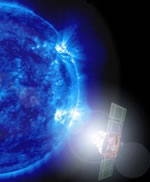
Image credit: ESA
The NASA/ESA SOHO spacecraft, which observes the Sun, is having problems pointing its high-gain antenna, which it uses to transmit data back to Earth. The cause of the problem hasn’t been figured out yet, but experts think there’s something wrong with its motor or in the gear assembly that steers the antenna – fortunately, its low-gain antenna is still working, so they can still communicate with the spacecraft. If they can’t figure out the problem, SOHO isn’t going to be able to transmit data back as quickly, so there will be blackout periods.
The ESA/NASA SOHO spacecraft, launched in 1995, has been delivering outstanding data about the Sun for over eight years. Recently, however, an anomaly on the pointing mechanism of its high-gain antenna has been recorded.
The high-gain antenna is required to transmit the large amounts of data from SOHO’s scientific observations to Earth. From SOHO’s orbit, the antenna has to be pointed in the proper direction – like a flashlight – for the data to be received at Earth.
The exact nature of the antenna problem is not yet known, but the experts think that a malfunction has occurred in its motor or in the gear assembly that steers the antenna.
SOHO is safe, as the spacecraft has a low-gain antenna, used to control the spacecraft and monitor both spacecraft and instrument health and safety, which remains operational. However, if the high-gain antenna problem persists, there will be periodic losses in the real-time transmission of scientific data of about two and a half weeks each three months. The first blackout is estimated to begin sometime late in the week of 22 June 2003.
A number of options are currently being investigated by the SOHO team to fully recover or minimise any real-time scientific data loss. A joint ESA/NASA press release will follow shortly.
Original Source: ESA News Release
Stardust Completes Course Correction
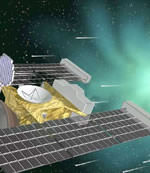
Image credit: NASA
NASA’s Stardust probe completed a minor course correction on Thursday, now only 198 days away from its destination: Comet Wild 2. The spacecraft fired its thrusters for 24 minutes and used up nearly 10% of its fuel. Stardust has traveled 2.9 billion kilometres since its launch in 1999, and if all goes well, it will reach the comet in January, 2004 and capture particles from its tail. It will then return the samples to Earth so they can be studied on the ground by scientists.
With 198 days before its historic rendezvous with a comet, NASA’s Stardust spacecraft successfully completed the mission?s third deep space maneuver. This critical maneuver modified the spacecraft?s trajectory, placing it on a path to encounter and collect dust samples from comet Wild 2 in January 2004.
At 2100 Universal Time (2:00 p.m. Pacific Time), Wed., June 18, Stardust fired its eight, 4.4 newton (1 pound) thrusters for a grand total of 1456 seconds, changing the comet sampler?s speed by 34.4 meters per second (about 77 miles per hour). This burn, the second in two days, completed the almost seven-year-long mission?s third deep space maneuver. The June 18 burn required 6.08 kilograms (13.4 pounds) of hydrazine monopropellant to complete. At launch, the spacecraft carried 85 kilograms (187 pounds) of hydrazine propellant.
“It was a textbook maneuver,” said Robert Ryan, Stardust?s mission manager at NASA?s Jet Propulsion Laboratory, Pasadena, Calif. “This was the last big burn we will have prior to our encounter with Wild 2, and it looks very accurate. After sifting through all the post-burn data I expect we will find ourselves right on the money.”
Stardust has traveled over 2.9 billion kilometers (1.8 billion miles) since its February 7, 1999 launch. At present, it is hurtling through the cosmos at 124,300 kilometers per hour (77,200 miles per hour).
In January 2004, Stardust will fly through the halo of dust that surrounds the nucleus of comet Wild 2. The spacecraft will return to Earth in January 2006 to make a soft landing at the U.S. Air Force Utah Test and Training Range. Its sample return capsule, holding microscopic particles of comet and interstellar dust, will be taken to the planetary material curatorial facility at NASA’s Johnson Space Center, Houston, Texas, where the samples will be carefully stored and examined.
Stardust?s cometary and interstellar dust samples will help provide answers to fundamental questions about the origins of the solar system. More information on the Stardust mission is available at http://stardust.jpl.nasa.gov.
Stardust, a part of NASA’s Discovery Program of low-cost, highly focused science missions, was built by Lockheed Martin Astronautics and Operations, Denver, Colo., and is managed by the Jet Propulsion Laboratory, Pasadena, Calif., for NASA’s Office of Space Science, Washington, D.C. JPL is a division of the California Institute of Technology in Pasadena. The principal investigator is astronomy professor Donald E. Brownlee of the University of Washington in Seattle.
Original Source: NASA News Release
Nozomi Makes its Earth Flyby
The Japanese space probe Nozomi, passed an important milestone on its journey to Mars Thursday night with the successfully flyby of Earth. The spacecraft passed within 11,000 km of the Earth in order to use our planet’s gravity to assist its trip to Mars. Its challenges aren’t over yet, however, since its heating system still isn’t functional and required in order to enter Mars orbit at the end of its journey. Space experts give Nozomi a 50/50 chance of being able to fix itself before reaching Mars.
Hubble Looks Way Back in Time
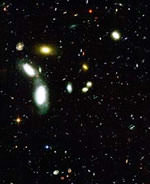
Image credit: Hubble
A new series of images taken by the Hubble Space Telescope contain 25,000 galaxies, many of which are interacting and in the process of formation. Some of these galaxies are so far away, they’re seen when the Universe was only 2 billion years old. Astronomers are using Hubble and the Chandra X-Ray observatory to survey two large areas of the sky to build a deeper understanding of galaxy evolution.
NASA’s Hubble Space Telescope reached back to nearly the beginning of time to sample thousands of infant galaxies. This image, taken with Hubble’s Advanced Camera for Surveys, shows several thousand galaxies, many of which appear to be interacting or in the process of forming. Some of these galaxies existed when the cosmos was less than about 2 billion years old. The foreground galaxies, however, are much closer to Earth. Two of them [the white, elongated galaxies, left of center] appear to be colliding.
This image represents less than one-tenth of the entire field surveyed by Hubble. The full field, consisting of about 25,000 galaxies, is part of a larger survey called the Great Observatories Origins Deep Survey (GOODS), the most ambitious study of the early universe yet undertaken with the Hubble telescope. This survey targeted two representative spots in the sky – one in the Northern Hemisphere and the other in the Southern Hemisphere. This image represents the southern field, located in the constellation Fornax. The entire GOODS survey reveals roughly 50,000 galaxies. Astronomers have identified more than 2,000 of them as infant galaxies, observed when the universe was less than about 2 billion years old.
Because infant galaxies are very faint and very rare, astronomers are using Hubble to search for them over a relatively wide swath of sky. In fact, the new observations cover about 60 times the area of the original Hubble Deep Field Observations, obtained in 1995. Astronomers also are using the Chandra X-ray Observatory to search the GOODS fields for the earliest black holes in the universe. The Space Infrared Telescope Facility (SIRTF) will sample these same fields soon after it is launched in August 2003.
By combining light from all three of NASA’s great observatories with data from ground-based telescopes, astronomers hope to build a coherent picture of galaxy evolution.
This image of the southern field was assembled from observations taken between July 2002 and February 2003.
Original Source: Hubble News Release
Shuttle Flights Will Probably Resume in 2004
Although NASA has made tentative plans to launch the space shuttle Atlantis some time near the end of 2003, it’s more likely to happen in early 2004. NASA is expected to announce the launch date in about six weeks. Although all the technical fixes can be made by December, one of the new regulations is that the shuttle will need to launch only in the daytime, so any problems during launch can be spotted from the ground – but there are only two daylight launch windows available in December. All shuttle flights were halted when Columbia broke up over Texas in February, 2003.
Soyuz Tourist Flights Beginning Soon

Image credit: Space Adventures
Two space tourists will have a chance to fly to the International Space Station in 2005, at a cost of only $20 million each. The flight will include a professional cosmonaut pilot and launch on board a Soyuz rocket from the Baikonur cosmodrome in Kazakhstan. The mission is being organized by Space Adventures, the company that organized the flights for Dennis Tito and Mark Shuttleworth. The Soyuz will completely self-sufficient, providing all the supplies required by the passengers and even some additional supplies for the station.
Commercial space flight took a giant leap forward today with the announcement by Space Adventures, Ltd., the leading space experiences company, of its plans to launch the world’s first privately funded mission to the International Space Station (ISS). Space Adventures recently secured a contract with the Russian Aviation & Space Agency (RASA) to fly two explorers to the ISS aboard a new Soyuz TMA spacecraft.
The mission, Space Adventures-1 (SA-1), continues the company’s record of opening the space frontier to explorers other than government astronauts and cosmonauts. The company brokered the flights for the world’s first private space explorers, American businessman Dennis Tito in 2001, and the first African in space, Mark Shuttleworth, in 2002. SA-1 has the potential to establish several world records, and also marks the first private mission to the International Space Station.
Space Adventures seeks candidates fascinated by one of life’s greatest experiences and who support the exploration of space to participate in the expedition. First “space tourist,” Dennis Tito said, “Private space exploration is an important investment into humanity’s future. Commercial human space flight and space tourism are creating the 21st century technologies and economy that will bring the benefits of space to people on Earth. Helping to make that happen is very meaningful. And of course, being in space itself is a truly blissful experience that I am unable to describe in words, it was worth far more than its cost; truly priceless.”
Space Adventures has established this mission through its longstanding partnership with RASA and Russia’s leading aerospace company, RSC Energia. “We are pleased to provide the means for this Space Adventures’ mission and are equally committed to the future of private space travel,” says Sergey Gorbunov, Press Secretary for the Director General of RASA. SA-1 participants will train in Star City, the cosmonaut training center outside of Moscow, familiarizing themselves with the Soyuz TMA spacecraft, experiencing weightlessness in a zero-gravity jet, and learning how to live and operate aboard the ISS. The mission is planned for liftoff in early 2005 from the Baikonur Cosmodrome in Kazakhstan and seats aboard the Soyuz are available for $20 million each. Gorbunov also stated, “In the future, we intend to carry out additional private missions to ISS in cooperation with Space Adventures.”
Space Adventures’ CEO, Eric Anderson, remarks, “After the loss of Columbia, the President said that our journey into space must go on. The advancement of commercial space flight and space tourism should and will continue, to everyone’s advantage. And, this mission in particular has been designed to provide great benefit to all parties, not only for the explorers who fly, but also to the ISS program as a whole.” Anderson emphasized that SA-1 will be self-sufficient, bringing its own food, water and medical supplies and that it may transport supplemental supplies for the resident crew aboard the ISS.
The announcement was made at the renowned Explorers Club in New York City on June 18. Accompanying Anderson at the event were Tito, Shuttleworth, and Gorbunov.
In addition to orbital flights to the ISS, Space Adventures, the world’s leading space flight experiences and space tourism company, offers a wide range of programs, from zero-gravity and Edge of Space flights, cosmonaut training and space flight qualification programs, to reservations on future sub-orbital spacecraft. Headquartered in Arlington, VA, with an office in Moscow, Russia, Space Adventures is the only company to have successfully launched private individuals to the International Space Station. The company’s advisory board comprises Apollo 11 moonwalker Buzz Aldrin; shuttle astronauts Kathy Thornton, Robert (Hoot) Gibson, Charles Walker, Norm Thagard, Sam Durrance and Byron Lichtenberg; and Skylab astronaut Owen Garriott.
Original Source: Space Adventures News Release
